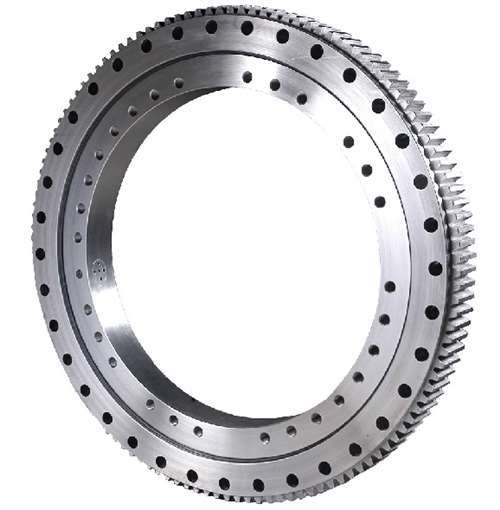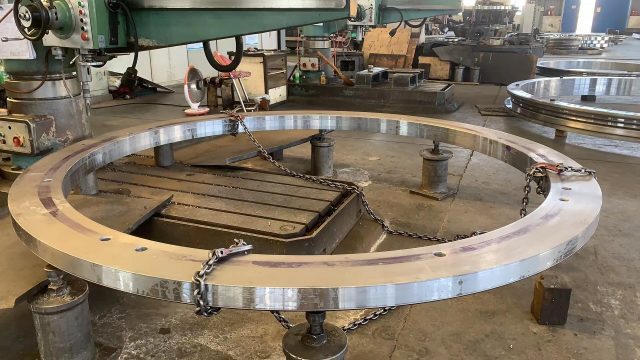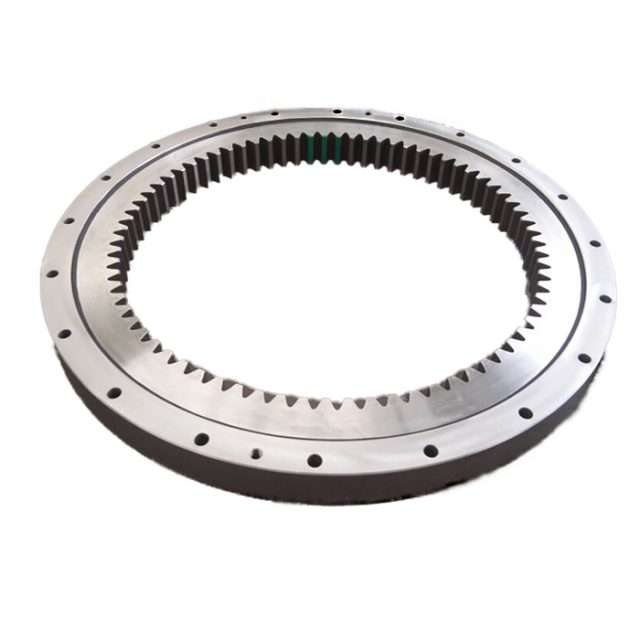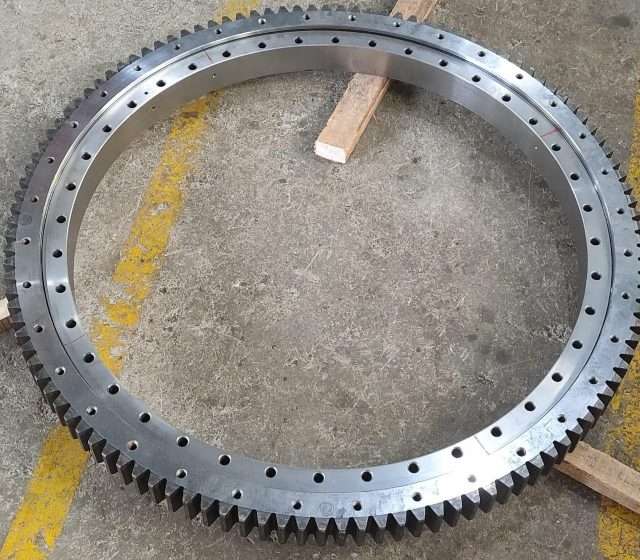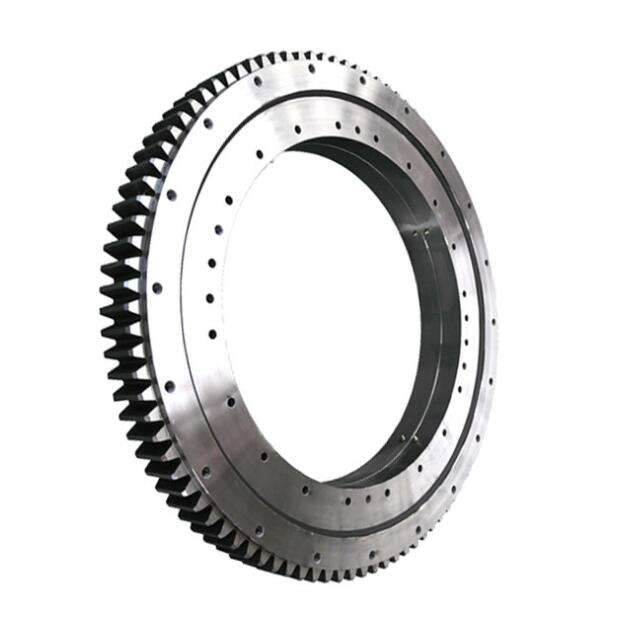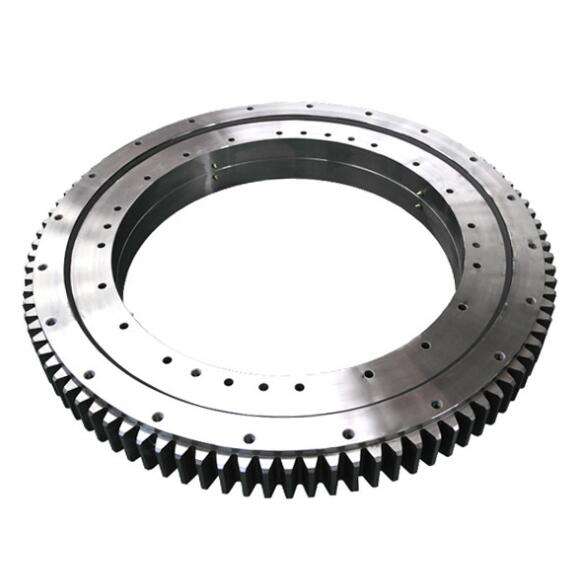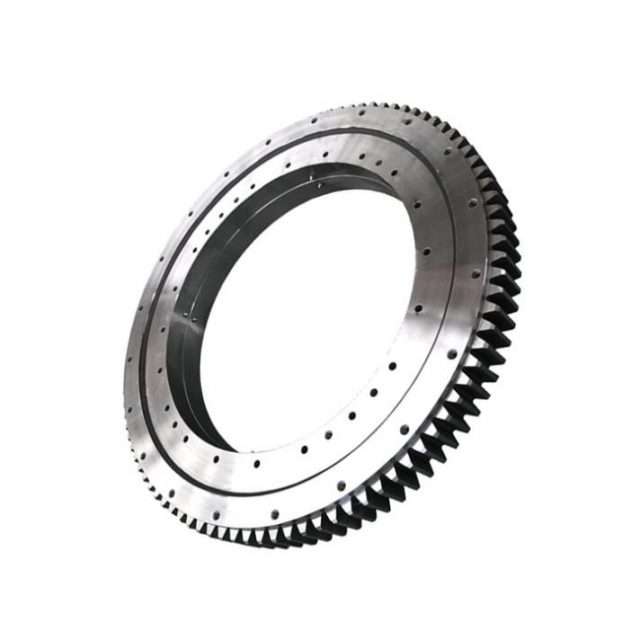4 point contact ball slewing bearing
1.Analysis of common faults of 4 point contact ball slewing bearing and preventive improvement measures
The damage of the slewing bearing is much more complicated than that of the general mechanical parts.
It is damaged in various forms and for different reasons. In addition to the own factors of bearing design and manufacture, most of the damages are caused by improper bearing selection, unreasonable design of support seat frame, weak rigidity and poor flatness of connecting surface, overload operation, improper installation, poor lubrication and poor sealing.
Strict and other factors related to use. Studying the damage form of the slewing bearing and analyzing the cause of the failure, on the one hand, can provide detailed information for the correct design and selection of the bearing, and then improve the design, select the bearing reasonably, give full play to the function of the bearing, and improve the economic benefit.
On the other hand, it is more important to improve the safety of use and avoid major accidents.
1. Failure caused by improper bearing selection
Correct and reasonable selection of slewing bearings is the guarantee to give full play to the function of bearings. If the mechanical design is not fully considered, overloading of the load can occur, resulting in the chipping of the rolling elements, the peeling of the raceways or the appearance of cracks.
Satisfying the bearing capacity is the primary consideration, the internal parameter design is the key factor, and the reasonable selection of materials and the heat treatment state of the materials is also important.
According to the actual working conditions of the main engine, the spatial position, the size and nature of the load, the rotational speed, the rotational accuracy, the friction torque and the installation method should generally be considered. In addition, the clearance of the 4 point contact ball slewing bearing is also a factor that cannot be ignored.
Generally speaking, for applications such as construction machinery, mining machinery and hoisting machinery, the bearing should usually choose a larger clearance.
If the clearance is too small, after the bearing is fixed, due to the poor flatness of the bearing, the bearing clearance will be reduced, which will cause the bearing to be stuck during operation or the rolling elements will squeeze each other. too high to cause failure.
On the other hand, due to the influence of the flatness of the bearing surface, the fixed bearing appears “wave-shaped”, so that the rolling elements are not on the same plane, resulting in excessive friction torque.
According to experience, in general, the clearance of the slewing bearing should not be less than 1.2 times the flatness of the mounting surface
2. Failure caused by insufficient rigidity of the supporting seat frame
The rigidity of the 4 point contact ball slewing bearing itself is not good. If the rigidity of the seat frame is insufficient, the slewing bearing will be deformed with the deformation of the seat frame, resulting in the unevenness of the original clearance, resulting in the uneven running of the bearing during operation and abnormal noise.
This situation has a particularly obvious impact on crossed cylindrical roller bearings, resulting in no clearance in many parts of the bearing, and wear between rollers and rollers, raceways and rollers due to mutual extrusion.
At the same time, the deformation of the seat frame will not only cause the raceway to separate and warp, affect the meshing clearance and meshing performance of the ring gear and the pinion, and then affect the working quality of the main engine, but also cause edge stress on the raceway and the rolling elements, causing the bearing Early failure.
The slewing bearing is fixed with the main engine by bolts, and the deformation caused by insufficient rigidity of the seat frame will cause uneven stress on the bolts under the action of external loads.
In order to improve the rigidity of the seat frame, the following aspects can be considered: the support seat should be subjected to sufficient aging treatment to completely release the internal stress;
the seat frame should be made into a hollow cylindrical structure as much as possible, and should have sufficient height; if welding is used For the seat frame, appropriate reinforcing ribs should be set to prevent the horizontal and vertical deformation of the seat frame.
Requirements for the seat frame structure:
1 The seat frame should have sufficient and uniform axial stiffness and horizontal stiffness, that is, the torsion resistance of the support frame must be good.
In order to withstand the axial force greater than the radial force, the car should have sufficient height.
As the external load increases, the diameter of the support will increase, and the elasticity of the seat frame will also increase, so the height of the seat and the diameter of the support should maintain a certain ratio. For cylindrical structures, the recommended diameter to height ratio is between 2.5:1 and 4:1. Regarding the truncated cone and the rectangular frame structure, it can generally be determined with reference to this ratio.
2 The seat frame should be made into a hollow cylinder as much as possible, and the cylinder wall should be arranged close to the raceway, so that the cylinder wall can directly transmit the load.
3. The plane of the seat frame is preferably processed by cutting, and the flange of the centering boss is reserved to prevent the radial side movement of the raceway.
Various 4 point contact ball slewing bearings have different requirements and service life for the installation plane accuracy, the rigidity of the seat frame, the allowable clearance increase in use, and the service life.
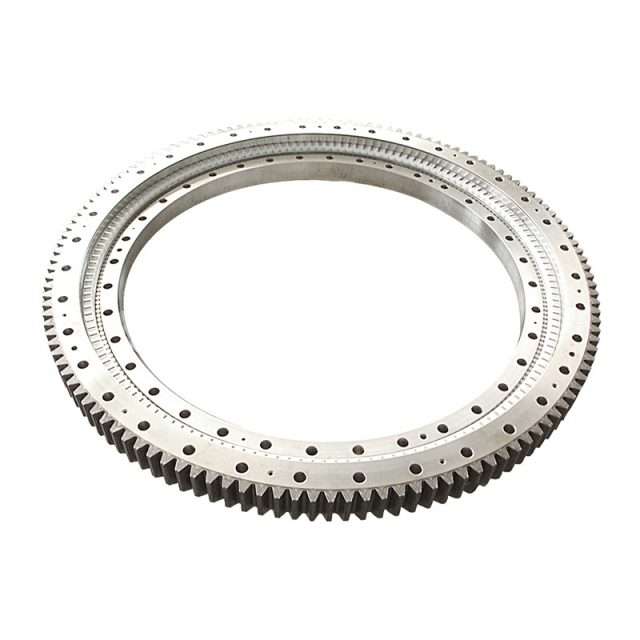
3. Faults caused by the flatness of the installation plane and the lack of supporting rigidity
Because the rigidity of the 4 point contact ball slewing bearing itself is poor and the axial bending resistance is weak, after installation, the bearing will deform with the processing quality of the installation plane under the action of the bolt, and the amount of deformation will increase with the reduction of the flatness of the installation plane.
After being loaded, the warping deformation will cause local deformation of the raceway, causing the rolling elements to be stuck when rotating or the bearing to make an impact sound when it rotates, and stress concentration will appear on the edge of the raceway, resulting in early damage to the bearing.
Before the 4 point contact ball slewing bearing is installed, the necessary inspection should be carried out on the mounting plane of the supporting seat. It is required that the supporting seat should not only have sufficient rigidity, but also the connecting surface should be machined, and the surface debris and burrs should be removed.
The technical requirements for the connecting surface of the supporting parts shall comply with the provisions in Table 1. Connection surfaces that cannot be machined shall be made flat by injection molding.
Four failures caused by improper installation
1 Insufficient bolt preload
The slewing bearing is usually fixed on the seat frame with bolts. When installing the bolts, pay attention to the diagonal method of installing the bolts. The pre-tightening force of the bolt should reach about 70% of the yield limit of the bolt.
If the preload is not enough, it is easy to cause the relative dislocation of the inner and outer rings when the bearing is under load, so that the contact angle changes, resulting in uneven loading of the rolling elements or edge stress between the rolling elements and the raceway. For the bearing with ring gear, the meshing clearance and meshing quality of the ring gear will change and the tooth surface will be damaged early.
2. Improper installation of soft belt position
The raceway of the slewing bearing ring is heat treated by surface induction hardening. This process method will produce a soft zone between the beginning and the end of the quenched zone, usually marked with S. When installing, the position of the soft belt should be placed in the non-loading area or the non-regular loading area.
Take a crane as an example, that is, the soft belt of the ferrule should be deviated from the main load direction by 90°, so that it deviates from the maximum load rotation area, so as to avoid the maximum working load at the position of the soft belt, so that the raceway will not be plastically deformed and ensure the use of the bearing. life.
Installation requirements for 4 point contact ball slewing bearings
(1) The accuracy and support stiffness of the installation plane should comply with the relevant regulations.
(2) Open the protective packaging of the slewing bearing in a clean and dry environment; clean each joint surface, remove iron filings, paint and anti-rust oil, etc.
(3) Observe and check whether the seal is still in the correct position, clean the installation plane and matching part of the slewing bearing, and the screw holes on the installation plane must be aligned with the installation holes of the bearing.
(4) High-strength bolts are used for connection; the support and the installation plane should be evenly tightened, and the specified pre-tightening torque should be achieved.
(5) Welding is not allowed on the finished product of the 4 point contact ball slewing bearing to avoid deformation of the bearing (except for the slewing bearing with special welding connection)
(6) On the installation plane, it should be considered that there are radially positioned convex and concave shoulders or fast positioning.
(7) The tempering zone of the support raceway plane surface quenching should be placed in the non-load or non-recurrent load and non-neutral load areas. The tempering belts of the upper and lower rolling rings should be installed staggered by 180°. The tempering belt of the moving rolling ring of lifting and excavating machinery should be placed at an angle of 90° to the direction of the boom; the tempering belt of the fixed rolling ring should be placed in a position with less frequent operation.
(8) In order to ensure the stable operation of the bearing, the rotating driving pinion and the teeth of the ring gear should reach the specified motion accuracy, work stability, contact accuracy and meshing backlash.
(9) After the installation work, the dirt and dust on the 4 point contact ball slewing bearing should be removed, and the exposed parts should be painted with anti-rust paint, and the raceway and gear parts should be painted with grease.
Five faults caused by poor lubrication
Lubrication plays an important role in prolonging the fatigue life of 4 point contact ball slewing bearings and reducing friction, wear and temperature rise. Without proper lubrication, bearings cannot work well, and many bearing damages are related to poor lubrication.
The lubrication of the slewing bearing is mostly grease lubrication, which can not only effectively reduce the friction force, wear and temperature rise on the surface of the friction pair, but also play a role in sealing and rust prevention. Although the working speed of the slewing bearing is not high, most of them work under heavy load, so the poorly lubricated relative moving surfaces are prone to adhesive wear and even burns.
At the same time, most of the slewing bearings work in the open air, and the high temperature and humid environment can cause the rolling elements and raceways to corrode quickly. For the lubrication of the slewing bearing, considering the influence of complex and comprehensive factors, the user can choose the best grease according to the specific requirements.
The lubrication of the raceways and gears of the slewing bearing is to be lubricated with grease. In this way, it can not only reduce the wear on the surface of the friction pair, but also play the role of sealing and rust prevention. In addition, high-pressure oil is also used to lubricate the slewing bearing.
1 Period of regular lubrication
For the slewing bearing raceway working in the environment of -20°~80°C, the maintenance can be carried out according to the following requirements:
(1) Working in an unclean environment and running continuously, lubrication should be carried out every 40 to 50 hours of operation;
(2) Work in an unclean and humid environment and operate intermittently, and lubricate immediately before and after work;
(3) Work in a clean environment and run intermittently, and lubricate every 3 to 6 months.
For slewing bearings that work continuously in high temperature and dusty environments, the lubrication interval should be appropriately shortened. Machines should be lubricated before and after long-term storage. The lubrication of the ring gear and the pinion should be determined according to the condition of the teeth. When the tooth surface is bright, grease is required. Generally, lubricate once every 2 to 3 months.
2 The method of raceway lubrication
(1) Connect the eight lubrication points of the pipeline with the centralized lubrication point, that is, centralized lubrication;
(2) Inject lubricant to the grease nipple of each lubrication point, that is, dispersion lubrication.
When adding lubricant, the bearing should be rotated, and the lubricant should be filled with all the space in the raceway, so that the excess grease can be squeezed out from the labyrinth or the gap of the seal, and the dirt, dust, etc. in the bearing should be taken out.
6. Damage caused by improper sealing
On the one hand, the sealing of the slewing bearing can prevent the leakage of lubricant, and on the other hand, it can also prevent the entry of water, dust and other impurities when used in the open air. If the seal is not good, the grease is not fully filled or leaked, the intrusion of moist air and water can cause the rolling elements and raceways to rust and peel;
The roughness of the working surface will shorten the life of the bearing; if the hard impurities enter the inside of the shaft, they will grind with the raceway and rolling elements, which can cause wear of the bearing, thereby increasing the clearance, or scratching the working surface.
The most commonly used seal is the sealing strip seal. This kind of seal is to process the sealing grooves on the inner and outer rings of the bearing respectively, and then add the sealing strips during assembly. This method can effectively prevent dust and impurities from entering the inside of the bearing, and can also prevent the leakage of lubricant. In some special occasions, the labyrinth seal is more reliable.
Inspection content and countermeasures of seals:
(1) Damage and aging of seals. Seals need to be replaced.
(2) The seal is overstretched and falls off. Need to adjust or reinstall.
(3) The lip of the seal is worn. It is necessary to replace the aged or severely worn seals to increase the lubrication of the lip.
(4) The bearing is in contact with the sealing lip. Contact areas need to be cleaned to remove sharp edges from friction areas.
7. Failure caused by the manufacturing quality of the retainer
The slewing bearing bears a large load and eccentric moment, which causes the uneven force on the rolling elements, which affects the smoothness of the bearing operation, especially in the case of continuous operation and high-speed operation,
it is necessary to design a suitable The retainer, but if the retainer is defective in manufacture, the strength is not enough, and the precision is not high, the retainer will be damaged, resulting in the rolling element stuck and the raceway damaged. Therefore, it is necessary to observe carefully in the daily maintenance, and replace the damaged parts in time if any abnormality is found.
8. Analysis of raceway and rolling element damage
Due to the wrong installation of raceways and rolling elements, overload operation, poor heat treatment, unreliable sealing devices, etc., the raceways and rolling elements will be damaged prematurely. The following lists the typical damage symptoms and introduces the main causes of raceway damage and the impact on the support work.
1 raceway peeling
Raceway spalling is also known as raceway denudation. This phenomenon is generally caused by poor heat treatment. Usually, the surface hardness of the raceway is too high (HRC>60) and the hardened layer is relatively thin, and the interface layer of high hardness and low hardness is caused by the alternating stress.
His characteristic is that the exfoliation is flaky. This kind of damage sometimes occurs at the junction of the tempered soft belt of the raceway.
2 Raceway and roller damage
(1) If the roller is inclined outward or the axis of the rolling ring is skewed, the raceway will be damaged.
In order to prevent the roller end surface from scratching the raceway, the length of the roller in the cross-roller slewing bearing is usually 0.5-1 mm shorter than its diameter. If the roller is shortened excessively or the upper and lower rings are separated due to loose connecting bolts, the gap between the roller end face and the raceway will increase; the skew angle of the short roller can increase the skew angle between the roller end face and the raceway.
If the raceway has defects (low hardness, unevenness, etc.), the edge of the raceway will be damaged due to the increased skew of the rollers, which may cause the rollers to jam along the diagonal line. In addition, if the rollers are stuck in the diagonal direction, the end face chamfers in the diagonal direction of the rollers will be damaged, and even the slewing ring will be braked.
(2) The quenching hardness of the raceway surface is insufficient (HRC<50), which will cause some raceway scratches.
(3) When assembling the support, if the support is accidentally impacted, the roller is skewed and the force is too large during assembly, the raceway of the rolling ring can be damaged.
3 Raceway wear
The causes of raceway wear are as follows:
(1) Due to the dust, sand, dirt and other particles mixed in the lubricating oil, they act as abrasives on the raceways and rolling elements, causing invisible metal peeling or peeling. This kind of wear can be felt in severe cases. Degree. In order to prevent such wear, the bearing should be provided with a reliable sealing protection device to prevent external media such as dust, sand, dirt and moisture from invading and rolling into it.
(2) When there is a lack of lubricating oil or insufficient lubricating oil in the bearing, under heavy load, due to the dry friction or semi-dry friction between the rolling element and the raceway, the raceway wear will be aggravated.
4 Causes of cracks in raceways
(1) The material itself is defective or improperly heat treated.
(2) When the rolling element and the raceway are rotating, the contact fatigue stress is very large, resulting in fatigue cracks.
5 Wear of rolling elements
The cross-roller slewing bearing has many sliding friction surfaces: the friction between the end face of the column and the outer circle on the raceway surface; the friction between adjacent ones.
The latter friction is often point contact at the beginning, the unit contact pressure is high, and it is in a state of dry friction and friction, and friction is generated, but as the contact area increases, the unit pressure decreases, which improves the lubricating strip on the contact surface.
The degree of wear is controlled. After this stage, a wear band with a width of 2~4 mm will be formed on the outer circle of the roller, which does not impair the working ability of the roller and the bearing.
6 steel ball broken
Due to the material or heat treatment defects of the steel balls, as well as foreign objects being trapped or improperly used, the steel balls will be broken, which can be judged from the sudden increase in the rotation resistance of the support and the abnormal sound during rotation.
If it is not eliminated in time, the fragmentation ball can scrape off large pieces of metal in the raceway, and even cause the thickness of the raceway to be reduced. In addition, sometimes the broken steel ball is embedded between other steel balls and the raceway, which will also cause the machine to lose its ability to rotate.
Application example 1: The source of the sound generated by the slewing bearing during operation
During the early use of the excavator, the slewing bearing often produced a loud metal impact sound. Users who use excavators generally believe that the sound when turning comes from the failure of the supporting slewing bearing core, and they are worried that the excavator will have an accident.
The solution to such problems by the after-sales service personnel of excavator manufacturing enterprises is to replace the slewing bearing. Because excavators usually operate in the field, the replacement of the slewing bearing requires a lot of work and requires lifting equipment, which will also seriously affect the construction period.
After visiting the after-sales service personnel and discussing with experts from some main engine manufacturing enterprises, it is believed that the following reasons are the source of the noise when the slewing bearing is used in the early stage.
1. The source of the sound of the slewing bearing during operation
At present, excavators at home and abroad preferentially adopt the structure type of single raceway ball slewing bearing. The rolling elements are separated by nylon material after special treatment, and the annular raceway is completely filled; the rolling elements make pure rolling motion in the raceway.
The commonly used process methods for raceway processing are: raceway forming processing – raceway surface heat treatment – raceway grinding. According to the raceway structure type and processing technology it adopts, it is impossible to produce metal impact sound.
Even if the raceway is crushed due to material and product quality control problems, there will only be excessive running clearance, and the problem can be clearly judged from the outside. The “raceway crush” failure mode produces no sound. Rolling element wear or damage has not been detected from statistical and failure mode studies.
Due to the difference in the selected material, quality and heat treatment process of the spacer block, the spacer block will be deformed and crushed, and the spacer block will be turned over if the reasonable accumulation gap is not adjusted during assembly, causing the rolling element to be blocked from rolling normally in the raceway. The failed isolation block will rub against the raceway under the action of the rolling elements during operation, producing a slight sound of “z-z”.
The single-row ball slewing bearing is loaded with steel balls and fixed. If the gap between the blocked and blocked holes is not well controlled during the manufacturing process, and the edge is not trimmed and the taper pin is not fastened, there will be a “da, da” when the steel ball passes here. continuous and regular sound.
2. When the excavator is assembling the slewing bearing, if the assembly quality is not well controlled during the installation process, it is easy to produce loud noises.
The upper and lower connecting plates for installing the slewing bearing are welded with plates. If the connecting plates are not properly aged, the unevenness of the installation plane after processing exceeds the minimum axial clearance of the slewing bearing from the factory, and the slewing bearing is connected with high-strength bolts.
Deformed, a point is “negative clearance”. This also occurs if there are burrs, iron chips, etc. on the installation plane. Due to the large size of the index circle of the slewing bearing gear, there is a roundness error, and the backlash is not adjusted to a reasonable backlash during installation.
When the large and small gears are in meshing operation, there may be no backlash or “negative backlash” at a certain position. The generation of “negative values” would require a larger driving force to cross these points. As a result, the structural parts of the excavator are twisted, resulting in dislocation of the connection, resulting in a loud metal impact sound.

